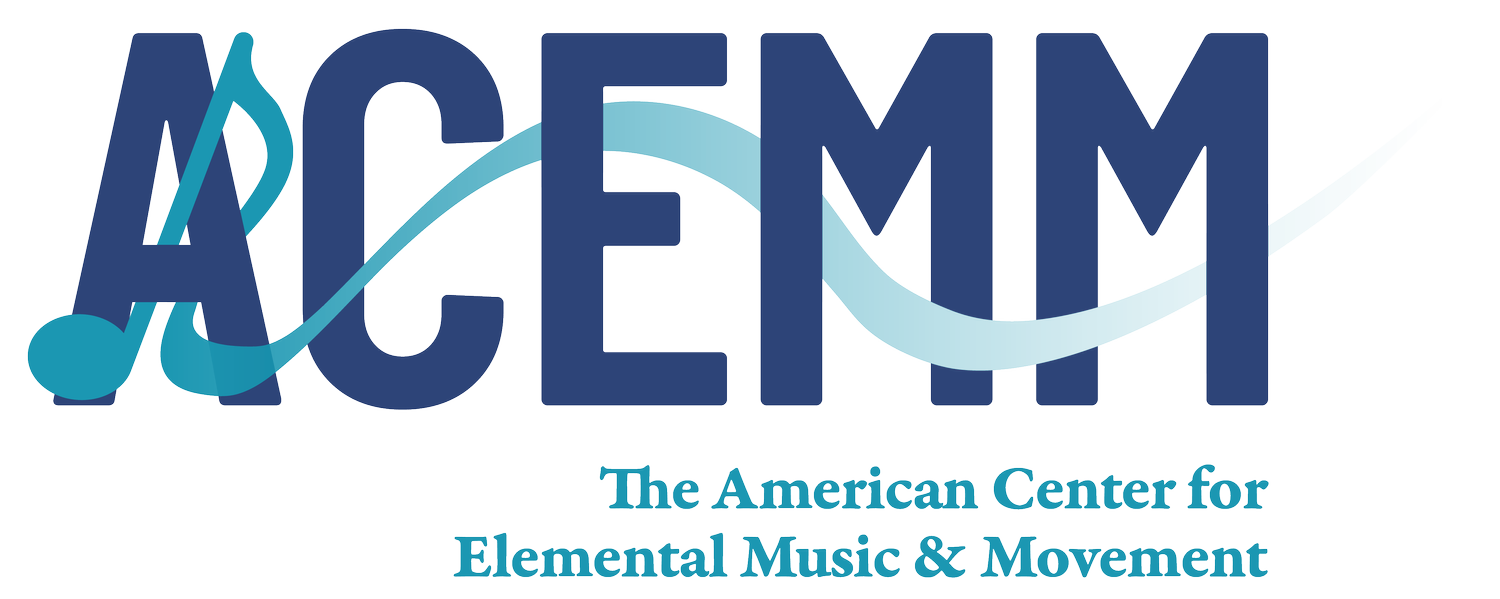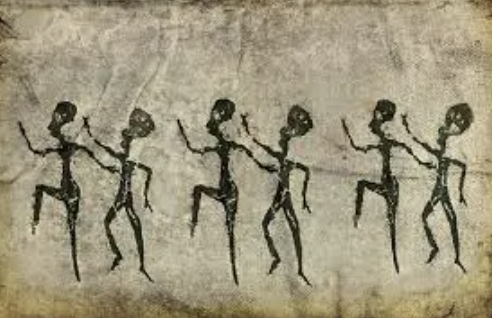The ‘What’ and ‘Why’ of Elemental Music
Reposted from March 26, 2017 by past-president Steven Calantropio
ACEMM was incorporated in February, 2012 by Donna Fleetwood, Michelle Przybylowski and me as an independent non-profit charitable organization whose mission was to support elemental music and movement teachers in America’s schools and communities. The need for aesthetic experiences in the arts for both children and adults is greater today than ever before as people suffer an increasing societal alienation as a result of the political and social changes that surround us each day. The arts, especially music and movement, provide an escape from the chaotic stresses of everyday and bring people together with the common goals of opening up the senses through music and dance.
What?
What is elemental music and movement? How is it different from other forms of musical and corporeal expression? Why have we chosen to promote this medium of expression over other, more obvious choices? I have spent much time pondering these questions and hope to give insights to the purpose of ACEMM in the following paragraphs.
Defining an artistic style is never an easy task. In looking at a particular medium of expression, one must consider what is part of the style and, just as importantly, what is not part of style. Artistic styles have many facets and usually occur in the context of a specific time period. There is a continuum of artistic events that lead to a ‘tipping point’ that sends one particular style tumbling into another. Aesthetic decisions reject previously well ordered choices and embody new ones based on existing social and artistic contexts. The clearly defined structures of the Classical period of music gave way to the Romantic era where the need for dramatic self expression became more important.
A primitive bone flute
Elemental music, on the other hand, is not bound by any time period or restrictions. It has been with us since human beings evolved into sentient creatures aware of their own feelings and the need to express them in some way. The roots of the elemental are timeless and originate in prehistory; the expression of urges, desires and wonderings found their way into primitive life. Elongated speech patterns became singing. The imitation of the heartbeat found expression in the recreation of this pulse as the foundation for group music-making. The vital breath became manifested in the blowing of a variety of natural instruments; animal horns, hollowed branches of wood or animal bones, conical sea shells, etc.. Even the taut string of a hunting bow could be plucked or strummed to produce a captivating musical tone.
Mouth Resonated String Bow
And, at all times, there was movement. The physical expression of what was heard and felt became intimately connected with the visceral movement of the body. Often the gestures needed to play on such a primitive instrument were inextricable from the dance that these sounds accompanied.
…at all times, there was movement”.
Such primitive music and movement was connected to rituals. Birth, death, the cycles of the earth, sun and moon, the growing and harvesting of crops all became scenarios that were made important through the association with music and movement. A strong belief in magic and its influences in daily life was expressed through singing, chanting, performing on instruments and dancing. The entire community was expected to participate and took great joy in doing so; their individual expressions becoming part of a group consciousness bound together through music and dance.
Why?
Consider elemental music as the soundtrack of the millennia accompanying the ascent of man and his civilizations. These ancient urges found contemporary modes of expression in each age and culture. As the arts became more specialized through the centuries and ‘professional‘ musicians and dancers were required with increasingly sophisticated skills, music and movement moved further away from the natural, organic modes of expression that had given rise to them. But, the elemental never disappeared although it was often superseded by the more classic representations of the media.
It is the modern reflection of those primitive needs that today express themselves in what we are calling elemental music and movement. The need to give voice to our basic aesthetic urges remains a part of the human psyche. The need to provide a medium of creation for this most human quality of the species calls out for an accessible and meaningful modality of expression that rejects the complex and highly intellectual for the simple and organic.
Elemental music and movement have been with us since the dawn of humanity and to a more or less degree, have remained an active expression of the creative spirit through the ages. It has run parallel to the increasing sophistication of art music just as two streams flow from a common source of water. One stream never replaces the other but in this case, the streams have continually moved away from each other in their ability to express basic human needs.
In the early part of the twentieth century, select composers and dancers knew that a return to the organic roots of music and dance had become inevitable and was developing partly in reaction to the increasingly abstract paths these artistic media had taken in the concert hall and partly as an expression of the general alienation of individuals from an increasingly mechanized and violent society. After experimenting for years with young female dancers who were required to create the music they danced to, German composer Carl Orff (1895-1982) and his collaborator Gunild Keetman (1904-1990) developed an educational philosophy based on the use of the elemental as a starting point. Dorothee Günther, who founded this institution known as the Günther Schule had this to say about the genesis of this approach:
“When I founded the Günther Schule in 1924, I wanted to discover a method of reviving the natural unity of music and movement-music and dance; a method which would be available not only to a few natural artists but would solve the education problem of awakening in everyone the sense of rhythmic movement, and of stimulating a love of dancing and music making—a general freedom of expression and receptivity. ”
This pedagogical approach came to be known as Orff-Schulwerk (school work) and was a conscious attempt to incorporate the basic organic impulses that had inspired our primitive ancestors into a sequential pedagogy for school children. Orff’s words reflect his belief of the timelessness of elemental music in the Schulwerk:
“…the ideas of an elemental music education are not new. It was only given to me to present these old, imperishable ideas in todays terms, to make them come alive for us.”
From its humble beginnings in Germany, the Orff Schulwerk approach has spread in many countries and school systems and is the most identifiable exponent of elemental music and movement. It has been widely, though not universally, accepted, as the foundation for a valid music and movement education based on its relation to the ancient artistic climate spoken of earlier in this essay. It encourages the immediacy of music creation at the expense of music reading, the improvised musical experience over the replication of previously notated compositions and the natural unrestricted use of the body as an instrument of expression rather than a tool to recreate fixed movement choreographies. The stimulus for artistic creation comes from societal and ritualistic starting points rather than abstract stimuli. The elemental favors processes and techniques that lead to a more immediate and personalized mode of self expression. What elemental creations lose in subtlety and sophistication, they gain in providing an artistic medium in which all can participate to some degree and on many different levels.
So where does ACEMM fit into this scenario? The organization is dedicated to the support of those teachers and directors who have accepted an elemental approach to their work. While proponents of the Orff Schulwerk approach are by their nature believers in the value of elemental music and movement, so are folk instrument players and groups, community choirs, ethnic dance groups, folk music researchers, banjo, dulcimer and guitar players, creative drummers, harmonica players; pretty much any individual or group that comes to music and dance without the need for sophisticated skills or techniques and without the need to make money or achieve fame. They play, sing, dance for the sheer joy in what they are doing; they reaffirm the ancient principles of our ancestors.
Much of ACEMM’s work is focused on the community of Orff Schulwerk teachers and educators. Such teachers are the largest single group of music and movement teachers who draw inspiration from the elemental. Orff Schulwerk educators are well aware of the important role they play as promoters of active music and movement education through the elemental.
However, I would like to use the President’s Forum to focus our reader’s attention on those other areas of elemental style that are not integrally part of the Orff Schulwerk approach. It is my hope that this column will help newcomers understand the concept of elemental style and to see the many ways that elemental desires and urges find expression in today’s world. I also wish to broaden the scope of the Orff Schulwerk pedagogue’s view of the elemental world by highlighting some of the other ways that elemental music and movement remain an integral part of artistic expression and creativity.
Steven Calantropio retired from an active career in public education in 2004. He taught music and movement in the River Edge, NJ public schools for 31 years prior to his retirement. During that time, Mr. Calantropio presented workshops and lectures in elemental music at many colleges and universities in the United States and internationally as well. His two most recent books Pieces and Processes and Lessons in Elemental Style have been well received by music educators and are published by Schott Music Comp. Steve’s innovative Master Class in Elemental Music was presented over 25 times during his years of teaching at various institutions of higher learning. In his retirement,
Steven holds certificates in Orff Schulwerk, Kodály, and Dalcroze from the Manhattan School of Music as well as a certificate from the Orff Institute in Salzburg, Austria. He taught Orff Level III courses for over 30 years and has been a guest lecturer, levels teacher, and conference presenter at Orff Schulwerk training programs in Canada, Sydney, Adelaide, Melbourne, and Hobart, Australia, Seoul, Korea, and at the Orff Institute in Salzburg. His two most recent books Pieces and Processes and Lessons in Elemental Style have been well received by music educators and are published by Schott Music Company. Steven’s innovative Master Class in Elemental Music was presented more than 25 times during his years of teaching at various institutions of higher learning. Mr. Calantropio retired in 2018 as the Education Director of the American Orff-Schulwerk Association, a position he held for 11 years. Steven is also the president and a founding member of the American Center for Elemental Music and Movement (ACEMM).




